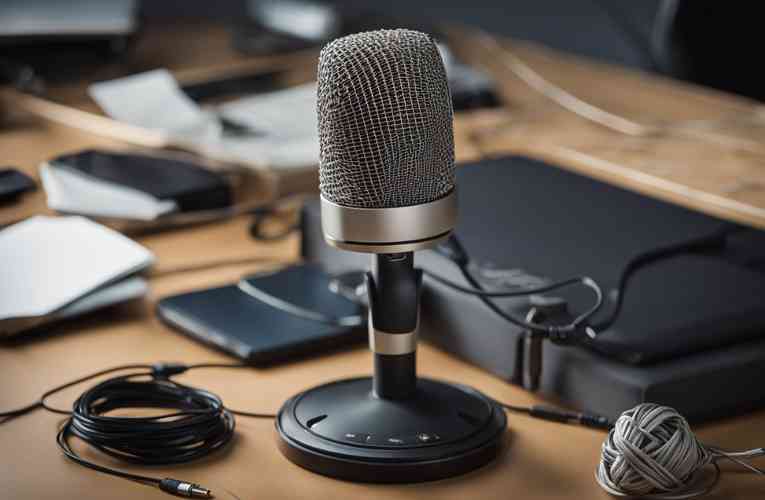Do you suspect that your condenser microphone is not performing as it should? Perhaps you’ve noticed a drop in audio quality, or it’s stopped working altogether. Don’t worry; you’re not alone. Condenser mics are sensitive instruments that can be damaged easily. Knowing how to identify the signs of damage can save you time and money.
In this article, we’ll explain how to tell if your condenser mic is damaged. We’ll guide you through the steps to troubleshoot and confirm the issue, so you can get back to recording your music or podcast. We’ll also answer some frequently asked questions about condenser mics.
So, if you’re ready to learn how to diagnose the problem with your condenser mic, let’s get started!
Key Takeaways
- Identifying the signs of a damaged condenser mic can save you time and money.
- Troubleshooting and confirming the issue can help you get back to recording.
- Frequently asked questions about condenser mics will be answered in this article.
Table of Contents
ToggleHow to Tell if Your Condenser Mic is Damaged?

If you’re experiencing issues with your condenser microphone, it could be due to damage. Here are some ways to tell if your condenser mic is damaged:
Visual Inspection
One way to determine if your condenser mic is damaged is by visually inspecting the electronic components and capsule inside the mic for any signs of damage.
Look for any cracks, dents, or other physical damage that could be affecting the microphone’s performance. If you notice any damage, it’s best to take your mic to a professional for repair.
Audio Performance Testing
Another way to determine if your condenser mic is damaged is to check the mic’s frequency response and compare it to the microphone’s expected frequency response.
If the mic is not producing the expected sound, it could be due to damage.
Physical Connectivity Check
Inspect the cable for any signs of damage, such as fraying or exposed wires, as this could also impact the microphone’s performance. If you notice any damage, consider replacing the cable with a new one to see if it resolves the issue.
By being attentive to signs such as distorted sound, increased background noise, inconsistent output, unusual noises, inconsistent sensitivity, or physical damage, you can determine if your condenser microphone is damaged and needs repair or replacement.
Related Posts:
- Top picks for vocal recording microphones
- Quick Fixes for a Quiet Condenser Microphone
- Factors affecting condenser mic durability
- Fixing the muffled sound on my condenser mic
- Solving hiss issues in condenser mics
Troubleshooting and Confirming the Issue

If you suspect that your condenser microphone is damaged, there are a few troubleshooting steps you can take to confirm the issue. Here are some methods you can try:
Using a Different Cable
One of the first things you can do is to try a different cable. Sometimes, a faulty cable can cause issues with your microphone.
Make sure the cable is firmly plugged into both the microphone and the preamp or audio interface. If your microphone utilizes XLR connections, confirm that the cable is securely plugged into both the microphone and the preamp or audio interface. If the microphone works with a different cable, then the original cable is likely the issue.
Testing with Another Device
Another way to confirm if your condenser microphone is damaged is to test it with another device.
Try connecting your microphone to a different audio interface, mixer, or computer. If the microphone works with another device, then the issue may be with your original device. If it doesn’t work with a different device, then the issue is likely with the microphone.
Consulting the Manual
If you’re unsure about how to troubleshoot your condenser microphone, consult the manual that came with it.
The manual should have troubleshooting tips and instructions on how to diagnose and fix common issues. Make sure to follow the instructions carefully and avoid any steps that may cause further damage to the microphone.
Professional Diagnosis
If you’ve tried all of the above troubleshooting steps and still can’t determine the issue, it may be time to seek professional help.
Contact the manufacturer of your condenser microphone or a professional audio technician for diagnosis and repair. They will have the necessary tools and expertise to identify the issue and provide a solution.
Related Posts:
Conclusion
In conclusion, detecting a damaged condenser microphone is crucial for maintaining the quality of your recordings. By performing a visual inspection of the electronic components, capsule, and the mic’s frequency response, you can identify any signs of damage.
Additionally, checking the physical connections and power supply can help address any issues stemming from faulty connections or inadequate power.
If you notice distorted or muffled sound, lack of clarity, or any other change in sound quality, it may indicate a problem with the microphone. Remember to handle your condenser mic with care and store it in a safe place to prevent physical damage.
Regular maintenance and servicing of your microphone can also help prevent damage and prolong its lifespan. Refer to the manufacturer’s manual for specific instructions on how to clean and maintain your microphone.
By following these tips and guidelines, you can ensure that your condenser microphone is in good working condition and produce high-quality recordings.
Frequently Asked Questions
What are the signs of a malfunctioning condenser microphone?
There are several signs that indicate a malfunctioning condenser microphone. Some of the most common signs include distorted or muffled sound, sudden drops in volume, or a complete lack of sound. Additionally, if your microphone is producing a lot of noise or feedback, it may be malfunctioning. If you notice any of these signs, it’s important to diagnose the issue as soon as possible to prevent further damage.
How can I diagnose a quiet output from my condenser microphone?
If your condenser microphone is producing a quiet output, there are several things you can check. First, make sure that the microphone is properly connected to your recording device. You should also check the microphone’s sensitivity settings to ensure they are set correctly. If these settings are correct, you may need to adjust your recording device’s input levels. If none of these solutions work, it may be time to replace your microphone.
What should I do if there’s no sound coming from my condenser microphone?
If there’s no sound coming from your condenser microphone, there are a few things you can try. First, make sure that the microphone is properly connected to your recording device. You should also check the microphone’s sensitivity settings to ensure they are set correctly. If these settings are correct, you may need to adjust your recording device’s input levels. If none of these solutions work, it’s possible that your microphone is damaged and needs to be repaired or replaced.
Can excessive volume damage a condenser microphone, and how would I know?
Yes, excessive volume can damage a condenser microphone. If you notice distortion or clipping in your recordings, it’s possible that your microphone has been damaged by excessive volume. Additionally, if you notice any physical damage to the microphone, such as a dent or crack, it’s possible that the damage was caused by excessive volume.
What are common issues after dropping a condenser microphone?
If you drop a condenser microphone, there are several common issues that can occur. The microphone may stop working altogether, or it may produce distorted or muffled sound. Additionally, the microphone may become more sensitive to handling noise or produce more noise and feedback. If you drop your microphone, it’s important to inspect it for any physical damage and diagnose any issues as soon as possible.
How can I determine the remaining lifespan or degradation of my condenser mic?
The lifespan of a condenser microphone can vary depending on several factors, including how often it’s used and how well it’s maintained. However, there are several signs that your microphone may be degrading or nearing the end of its lifespan. These signs include reduced sensitivity, increased noise and feedback, and distortion or muffled sound. If you notice any of these signs, it may be time to consider replacing your microphone.








